
Foxton greyhound trainer Marcie Flipp has been in the business 28 years and is unsure what her next steps will be once a racing ban comes into effect.
“I think my property won’t be worth a lot as it has been set up specifically for housing and training greyhounds,” she says. “It cost a lot of money to get to this stage.”
She’s had to redo the boundary fence of her property, created runs and built a big shed. She’s been training greyhounds in Foxton since 2015.
Racing Minister Winston Peters announced a ban on greyhound racing late last year, with it to come into effect in July next year.
Marcie picked Foxton as a kind of in-between place for the dog tracks in Whanganui and Palmerston North. She has 24 race dogs, six of whom will retire this year and another four will go next year.
Retired dogs sometime goes out for rehoming, but she has kept quite a few herself.
“I just cannot part with them. Every time I go to GAP {Greyhounds as Pets] with a dog to rehome I cry. I always hope the new owners will get back in touch as I would like to know how they are getting on. Parting is really hard.”
She got a big surprise recently when I turned up with my greyhound Ester, a timid dog wary of strangers, who embraced Marcie and her mum straight away.

Foxton greyhound trainer Marcie Flip was delighted to catch up with Ester, one of her former charges. Photo Janine Baalbergen
Marcie says she expects she will gradually reduce the number of active dogs she has.
“There are so many restrictions now. For Example, you can’t race dogs until they are 16 months old and I tend retire mine at 4 or 4½.
“While they love to run, we are very restricted in what we can do.
“An average run is 18 seconds and you can only race them seven times a month. We now need to have three days rest in between races. It used to be two days. This means they race an average 2½ minutes a month.”
Dogs are not cheap to raise or keep and she doesn’t think it would be worth breeding solely for rehoming.
“They would just be too expensive for people. You’d be talking thousands of dollars.”
Marcie says she often takes hurt dogs home for rehabilitation. If it happens at the track, Greyhound Racing NZ pays for it, but when it happens at home, the owner and trainer foot the bill.
She says track conditions have improved over the years but more straight tracks would have helped.
“It’s too late now.”
Marcie says injuries are usually minor.
“But everything must be reported and a dog must stand down. A broken toe nail is recorded as an injury..”
GRNZ spends $7 million a year on animal welfare, fixing inured dogs and rehoming them via GAP.
“Sadly no-one seems to have thought about the follow-on effects of the ban. We lose jobs, or our business, but we also use mechanics for our vehicles, local butchers for meat for the dogs, we shop at Farmlands and use vets, who will also have less business.
“No thought is given to rehoming 2700 dogs and there is no talk about compensation for people who have been greyhound racing for decades, or even generations.”
Marcie says the hours are long, then there’s travel to tracks. On one recent week she had two days working from 5.30am to 8.30pm.
“And for the animals we are on call 24/7.”
She says she finds it disturbing that people opposed to racing film greyhound races from over the fence as they are no longer allowed inside.
“Sometimes it seems they almost rejoice when something goes wrong and a dog gets hurt.”
OTHER STORIES








